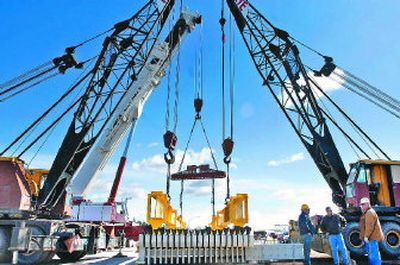Bridge mover finally unburdened

With the burden of the Tacoma Narrows Bridge project behind it, Big Boat Movers wasted no time putting the state of Washington in its rearview mirror Tuesday.
“This job’s just about cost me my marriage,” trucker Ed Carothers said. “I’ve been away from home for the last 2 1/2months.”
Texas-based Big Boat was supposed to deliver a massive bridge expansion joint to Tacoma more than three weeks ago. It drove its more than 300,000-pound load and trailer across five states without a hitch, but became bogged down in the Spokane Valley after weigh station officials March 17 deemed the company’s trailer too small to continue. Tuesday, the expansion joint was transferred to another trucking company, Omega-Morgan Rigging and Industrial Contracting of Tacoma.
The steel and neoprene part is needed to connect the bridge to land, and can expand and contract in the event of an earthquake. Omega-Morgan planned to hit the road Tuesday night, but soon discovered the load had its own schedule.
It took three cranes, working just west of the Pines Road/Interstate 90 intersection, more than 10 hours to make the transfer. The expansion joint had to be raised several feet just so Carothers could drive his trailer out from under it. Freed from the load, the trailer seemed to rise at least a foot. Late Tuesday, Omega-Morgan was just getting its truck positioned under the load. With a weigh-in and brake tests still to be done, the five-day, 15-mph trip to Tacoma was put off until today.
To weigh the load properly, the Washington State Patrol’s commercial vehicle division had to round up every available portable scale it had in a four-county area, spokesman Nicholas Hopper said.
Stretching 200 feet with a net weight of 429,000 pounds, the 16-foot-wide load is now larger than it was when it entered the state. The load is expected to take up the better part of two interstate lanes. But because the weight is spread over a wider area, Transportation Department officials were confident the load was less of a threat to Washington’s bridges than Big Boat’s 330,000-pound configuration.
“It is big, but obviously we’ve issued the permit so as far as we’re concerned they have met the requirements,” said Kelly Stowe, DOT spokeswoman.
Meanwhile, Big Boat is heading to Sioux Falls, S.D., to pick up an identical expansion joint for the opposite end of the bridge. Company spokesman Mike Love said Big Boat will transport the joint from Sioux Falls to Post Falls using the same trailer Washington rejected. Once in Post Falls, the load will be handed over to Omega-Morgan. The other states along the route had no problem with Big Boat’s trailer, Love said. Delays in the project have nearly crippled his company.
“We’re going to do everything we can to survive,” Love said. “We’re going to go get the other one.”
The reason the handoff to Omega didn’t happen sooner is because Big Boat spent 24 days trying to modify its trailer to pass Washington law. The company attempted to rent axles from a local house mover in order to widen its load to 16 feet as DOT suggested, but when the axles arrived, they lacked brakes, Love said.
Big Boat then attempted to rent axles from a trucker in Oregon. The axles were en route when the company that hired Big Boat – expansion joint builder D.S. Brown – pulled the plug.
Omega was called in, ending a hauling ordeal with plenty of unusual twists.
D.S. Brown actually built the expansion joints just outside Minneapolis. Minnesota officials wanted the heavy bridge parts out of the state before the spring thaw softened the soil beneath that state’s highways. Big Boat moved both parts to South Dakota, then continued on with one of them.
DOT has taken some public criticism for not letting the expansion joint pass as other states did. But shortly after Big Boat stalled in the Spokane Valley, Doug MacDonald, Washington’s transportation secretary, wrote an op-ed piece for the Tacoma News Tribune placing the blame squarely on Big Boat for not meeting the conditions of its hauling permit for Washington. He said Big Boat movers had “made a mess of it” by arriving at the border with a rig that did not meet specifications.
DOT is also the agency overseeing the Tacoma Narrows project. Stowe said the expansion joint’s delay isn’t slowing the Tacoma Narrows project. The bridge construction is four months behind schedule, due to bad weather and miles of corroded bridge cable delivered to the project that had to be replaced.
The expansion joint delay is not expected to increase the project’s fixed cost of $615 million, according to the DOT.